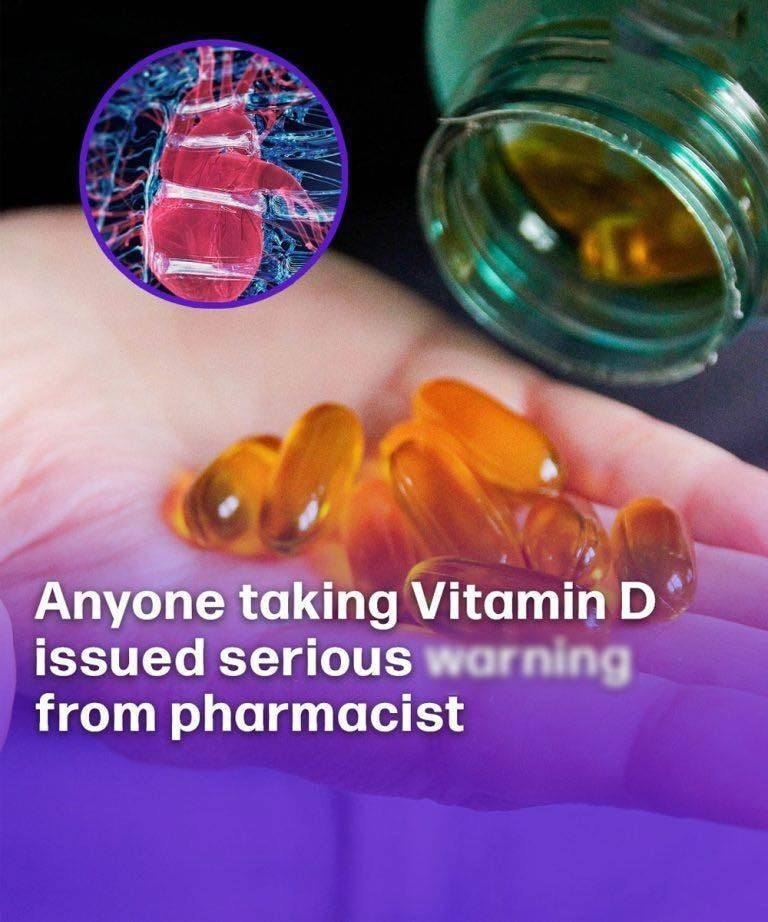When vitamin D levels rise too much, one of the principal problems is hypercalcaemia (too high calcium levels in the blood). Because vitamin D increases calcium absorption, excessive intake can lead to dangerous calcium buildup in tissues. Wikipédia+1
Here are the key risks:
-
Kidney damage: High calcium can lead to nephrocalcinosis (calcium deposits in the kidneys), decreased kidney function or even kidney failure. The Times of India
-
Heart rhythm problems: Elevated calcium can interfere with cardiac electrical activity, increasing risk of arrhythmias. EatingWell
-
Bone and soft‑tissue calcification: Instead of strengthening bones, excess vitamin D can cause calcium to deposit in soft tissues, arteries and joints—leading to stiffness and pain. Wikipédia
-
Symptoms of toxicity: Nausea, vomiting, weakness, frequent urination, thirst, confusion and even coma in severe cases. bmjgroup.com
4. How Much Vitamin D Is Safe?
-
UK guidance: For most adults, maximum recommended is 4,000 IU (100 µg) per day unless otherwise advised. Tyla
-
Research shows that doses of 10,000 IU/day in healthy adults may remain under toxicity thresholds, but safety depends on the individual situation (age, kidney health, other medications). PMC
-
Toxicity cases often involve massively high doses (tens of thousands of IU daily) or use of erroneous supplements. Wikipédia+1
Key takeaway: What is safe for one person may not be safe for another. Always base supplementation on testing and professional advice.
5. Who’s at Higher Risk?
Certain groups should be especially cautious:
-
People with kidney disease, reduced kidney function or on dialysis. High vitamin D may overload impaired kidneys.
-
Those taking medications that interact with vitamin D or calcium (e.g., cardiac glycosides, thiazides). EatingWell
-
People using multiple supplements or “mega‑dose” regimens without monitoring.
-
Older adults, children and infants: cases of toxicity from mis‑dosage occur more in these populations. PMC
-
Individuals using poorly regulated supplements, especially via internet imports or unverified sources.
6. Signs & Symptoms of Excess Vitamin D
Because vitamin D toxicity often develops gradually, recognising early warning signs is key:
-
Excessive thirst and frequent urination (polyuria)
-
Nausea, vomiting, loss of appetite
-
Weakness, muscle pain, bone pain
-
Confusion, drowsiness or even altered mental state
-
Elevated blood pressure, arrhythmias
-
Kidney‑related signs: high creatinine, low urine output, calcium deposits in kidneys
If you’re taking high‑dose vitamin D or combine it with other supplements/meds, and you notice these signs – stop and seek medical advice.
7. What to Do If You’re Taking Vitamin D
-
Get tested: Ask your doctor for a 25‑hydroxyvitamin D blood test, plus calcium, kidney function and maybe PTH (parathyroid hormone) if indicated.
-
Review your dose: Are you within recommended limits? Is supplementation tailored to your needs (e.g., deficiency vs. maintenance)?
-
Check your other meds/supplements: Are you combining high doses of vitamin D with other agents that increase calcium or affect kidneys?
-
Use regulated products: Choose supplements with third‑party testing, accurate labelling and known source.
-
Monitor long‑term: Especially if you take more than standard doses – discuss monitoring intervals with your healthcare provider.
-
Lifestyle first: Get sensible sun exposure (if safe), eat vitamin D‑rich foods (oily fish, fortified dairy/plant‑milk), and only supplement as needed.
8. Bottom Line
Vitamin D is important—but not immune from harm. The recent warning from pharmacists and healthcare professionals is a reminder: supplementation must be handled thoughtfully, especially when taken long‑term or in high doses.
If you’re taking vitamin D regularly, make sure you know your dose, reasons for use, and that your health is monitored. In doing so, you’ll reap the benefits—and avoid the risks.

